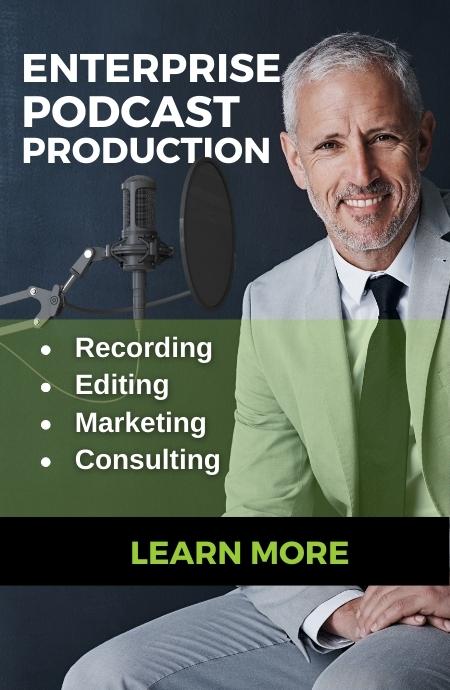If you’re still asking whether you should do “audio or video” when launching a company podcast, you’re already behind. The most effective marketers understand that a video podcast isn’t just an add-on. It’s the core starting point, and audio is the natural (and useful) byproduct.
For most of the business world, podcasting still conjures thoughts of headphones, subtle voiceovers, and long commute-friendly audio streams. But the truth is, the meaning of “podcast” has changed dramatically. Video podcasting is the new standard for businesses and brands that want to lead, not follow, in their industry.
A New Era: Video Podcasting Is the Default
Years ago, outside of a big production, no one would have imagined putting company executives in front of a camera for a fireside chat or roundtable discussion. Audio podcasting was simple, discreet, and low-friction. But as attention shifted to social networks, engagement started to require one thing: a visual.
Today, when companies ask for a podcast, they typically mean video podcasting, and most simply assume that visual content will be part of the package. Why? Because video delivers what audio cannot: discoverability, trust, and human connection.
Audio Podcasting’s Limitations in the Age of Discoverability
Let’s be clear, there is still value in recording a great audio podcast. Audio fits seamlessly into people’s day – during commutes, workouts, or lunch breaks. Yet, where do you put it so people will find it? If you are relying solely on audio, your ability to be discovered is practically zero unless you possess a large, engaged email list or a powerful promotional engine.
You don’t own a direct channel to audiences just because you publish on Apple Podcasts or Spotify. Neither will promote your show – that’s your job. With no visual component, your only hope is to push notifications, emails, or share links across platforms, hoping someone clicks through and listens.
Why Video Podcasting Supercharges Your Brand
Video podcasting changes the game. No other format gives your brand a face as quickly or as authentically. If your goal is to showcase expertise, build credibility, or humanize your leadership team, you need to show up visually.
Here’s why the best companies embrace video podcasting:
- Greater Discoverability
Platforms like YouTube are built for search and sharing. With clips, shorts, and full episodes, your content becomes discoverable to people outside your network – even total strangers. Unlike LinkedIn or audio-only directories, YouTube and video-centric platforms proactively recommend content based on interests, not just existing connections. - Content Repurposing
A single recorded video conversation can become a dozen assets: short social posts, shareable reels, blog articles, and of course, the full-length podcast itself. Each visual moment amplifies your message. - Human Connection
People trust people. A face on screen builds familiarity and allows viewers to see the emotion, authenticity, and expertise behind your words. Video humanizes your brand, making your executives and experts not just voices, but visible authorities.
Lowering the Barrier: It Doesn’t Have to Feel Like TV
One common misconception is that video podcasting means full-scale television production. Not anymore. Modern tools and remote production services allow you to capture high-quality video podcasts easily, often with less effort than the business “Zoom calls” you already do daily.
The lift can now be as heavy or as light as you need. The right production partner can guide your team through remote coaching, lighting, scripting, and post-production. That means your executives or subject matter experts can join from wherever they are – whether it’s the office, a home office, or a beach house.
The pandemic proved audiences accept geographic authenticity. You no longer need a film studio; you just need to look and sound professional. With a bit of coaching and polish in post-production, the difference between a five-figure shoot and a quick-turn video podcast is nearly undetectable to viewers.
Audio Is Not Dead – But It Shouldn’t Be Your Starting Point
There’s no harm in capturing audio. In fact, once you record a video podcast, you already have the audio ready to distribute. But if you reverse the process and focus solely on audio, you miss out on every visual opportunity to promote, share, and build organic reach.
The most powerful outcome of podcasting for business isn’t just the raw listenership – it’s the relationships, exposure, and thought leadership that grow from sharing conversations widely. A podcast is a perfect platform to connect with customers, prospects, and industry peers in a meaningful way. But only if they find it, only if you share it, and only if it showcases your brand in a modern, compelling way.
Telling Your Brand’s Story Isn’t Just Audio
A strong brand is never just audio. Visuals matter. Logo, color, personality, and, yes, the human element are all critical. Video podcasting gives you options: add charts, product visuals, or event footage. Clarify the conversation with illustrative graphics. Make your content memorable with the right editing.
You no longer need to bring in a film crew or rent expensive space. Smart video podcasting makes brand storytelling accessible and scalable. All you need is the right process and the understanding that real value comes from naturally flowing conversations, not staged and scripted perfection.
Start with Video Podcasting, Then Extract the Audio
There is no longer an “either-or” in podcast strategy. Start with video podcasting. Build your discoverability, deepen your relationships, and present your brand as the leader it should be. The added benefit? You already have the audio, too.
Businesses that adopt video podcasting now will leave their audio-only competitors behind. The process is less intimidating and more rewarding than you imagine.
The time to lead is now. Start with video, put your people on the virtual stage, and share your voice with the world. Your prospects, customers, and audience are waiting to watch.

